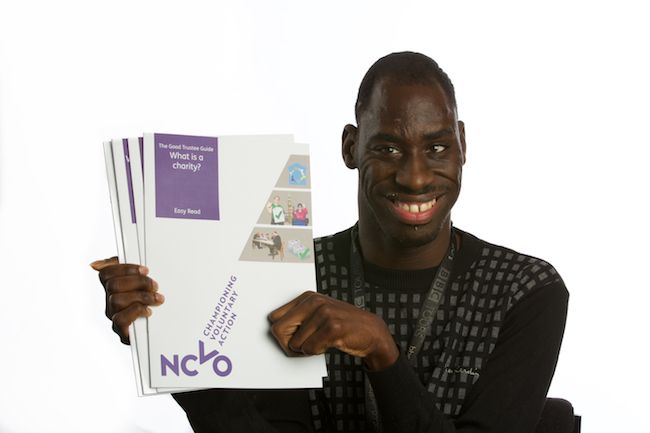
Michael Hagan, Service User Trustee of The Advocacy Project, holding the four easy-read booklets of The Good Trustees Guide by NCVO.
Introducing an easy-read guide from The Advocacy Project and NCVO
The role of a trustee is an important one. But research shows that trustees often share similar ages, backgrounds and opinions. To avoid a narrow agenda and decisions going unchallenged, greater diversity is vital.
The Good Trustee Guide from the National Council of Voluntary Organisation (NCVO) provides guidance on the role and responsibilities of trustees. It’s widely used and respected – but it speaks to the typical current trustee.
In an effort to increase the diversity – and effectiveness – of trusts, the NCVO invited us to work with them to make the guide more accessible. We broke it down into four different topics, distilled the content, simplified the language and added images. Then the content was sense-checked by people with learning disabilities. Their feedback helped to shape the four finished booklets, which appeal to a far wider audience, including those with learning disabilities.
“I like the guide because it has clear pictures and words that are well spaced out and there is no jargon. The guide should help lots of people understand about being a trustee and, as a person with a learning disability myself, I hope it will get others interested in these leadership roles.” Matthew Smith, trustee of Thera Trust.
Charities that speak for everyone
Because they demystify and clarify what it means to be a trustee, the easy-read booklets will fulfil three key functions:
- Helping existing trustees with learning disabilities to understand their role better.
- Attracting more people with learning disabilities to become charity trustees.
- Supporting learning disability charities to recruit more people with learning disabilities to join their boards – so that their services and structures better reflect the needs and wants of their users.
By helping charities to attract and keep a wider range of people, the booklets will help make sure charities are run in an inclusive and effective way.
“By attracting more people with learning disabilities to become trustees, charities working in this area can make sure they have the right mix of skills, knowledge and experience on their boards, so they can better meet the needs of their beneficiaries.” Sir Stuart Etherington, Chief Executive NCVO.
Four booklets that speak to everyone
Each booklet covers one key topic:
- What is a charity
- What is a charity trustee
- What trustees must do
- How trustees look after the charity.
Click on the links above to download your free copies.